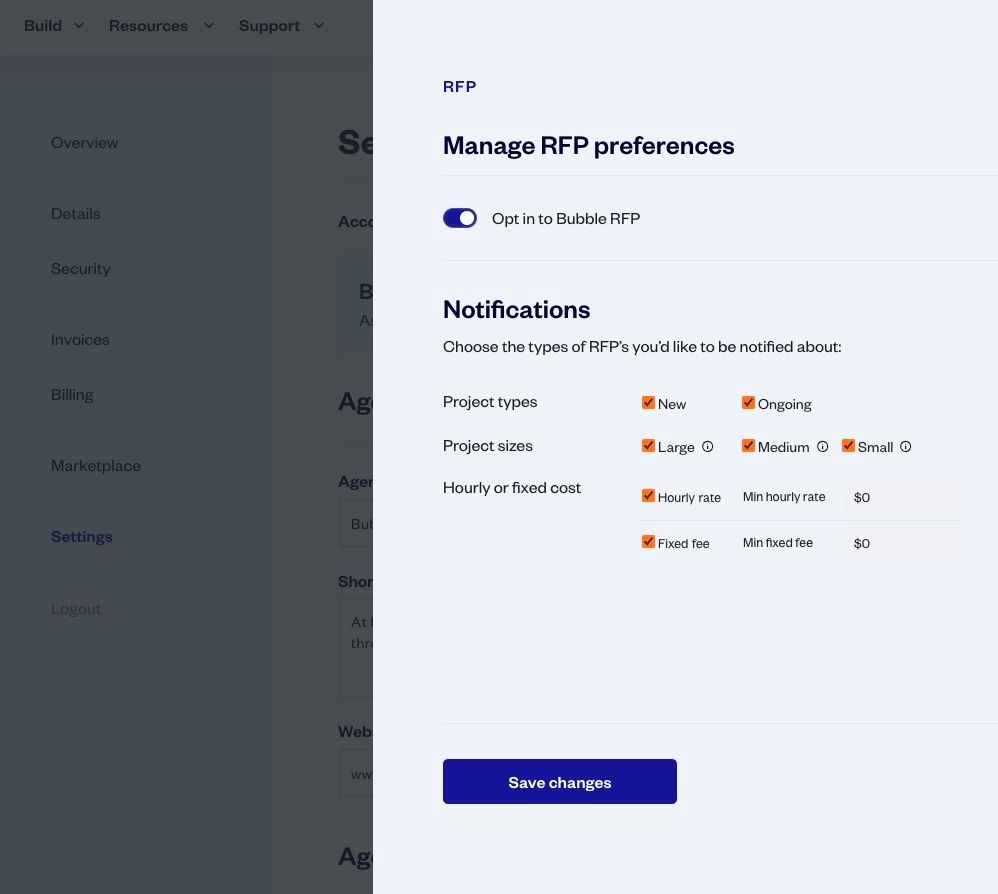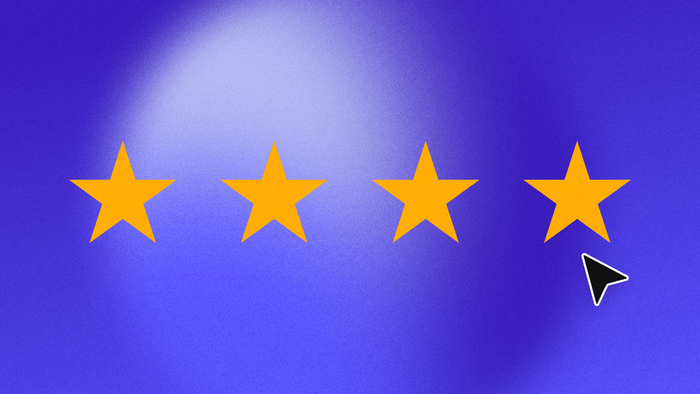Ask any freelancer and they’ll tell you: Doing good work is only half the job. Winning new clients is a critical part of the freelance hustle.
Fortunately, professional Bubble Developers have a leg up when it comes to landing gigs, because no-code outcompetes traditional development on speed and cost. The trick is to make sure potential clients know about you, your skills, and the benefits of hiring a Bubble dev.
We wrote this guide to give you an insider’s view into what makes professional Bubble Developers successful. It draws on years’ worth of learnings gained from working with agencies and devs like you — and from running the Bubble RFP (request for proposals) system that connects clients with agencies.
We’ve broken winning more clients into six key steps, which we’ll go through one-by-one:
- Set yourself up on a Bubble Agency plan
- Optimize your agency profile
- Leverage Bubble’s RFP portal
- Cast a wide net
- Give a strong pitch
- Earn referrals by building strong client relationships
Ready? Let’s get you on the path to a more successful Bubble development business.
1. Set yourself up on a Bubble Agency plan
The first thing you’ll want to do is sign up for a Bubble Agency plan, which is designed for all professional Bubble Developers, even if there’s only one of you. The Agency plan offers some key features that other plans don’t include, like:
- Pay per seat, not per app: This is the only plan built to fit the way professional developers work. Instead of charging on a per-app basis, it’s charged per seat — the number of developers using Bubble at your company. (And yes, solopreneurs can sign up for a single-seat Agency plan.) Then you and your team can build as many apps as you want. And after you officially transfer an app to the client’s plan to deploy, you can even stay on as a collaborator to their app for free.
- The Bubble app API: You can give other services access to read your app’s database or trigger workflows, which lets you build apps that integrate into clients’ existing tech stacks.
- Free Plugin subscriptions: Build with plugins that normally require a paid subscription for free until you've transferred the app to the client’s plan to deploy.
- More premium features: Including version control, extended server logs and data retention, and more. Check out bubble.io/agency for all the details.
(One thing to note: Because an Agency plan allows you to build but not launch, bulk data operations and JSON import/export aren’t available. After you transfer the app to a client on a paid plan and deploy the app, you (and your client) will be able to access these features.)
2. Optimize your Agency profile
All professional Bubble Developers on Agency plans have a profile in our agency directory. Your agency profile is a place for you to tell your story, showcase your work, and tell potential clients more about your process. It includes:
- Featured Work and Services: Share examples of apps you’ve built and projects you’ve worked on. Let would-be clients know what services you offer and how you like to work. Tell your story using text, images, and video clips.
- Reviews: Show off client feedback and testimonials using our integration with Clutch, and link to other references and review sites where you collect feedback.
Your profile also features quick stats that we’ve compiled about you and your contributions to the Bubble marketplace — plus a link to let prospects contact you directly, bypassing the open RFP proposal process and helping you get better leads.
With an active Agency plan, you can change or update your profile any time in your account settings. Once it’s live, prospective clients will see it when they click through to your listing from the directory or when you respond to an RFP request.
To learn more about getting up and running in your early days, read How to Become a Freelance Bubble Developer.
3. Leverage Bubble’s RFP portal
Active Bubble agencies have access to our free RFP (request for proposal) portal, where developers can bid on client projects.
How it works
Clients who need a professional Bubble Developer request proposals and specify their budget, project size, and desired scope. As an agency, you can use filters — like a minimum budget size — to be notified via email as soon as certain types of RFPs hit the portal.


When you send a proposal to a prospective client, they’ll get a notification to view your proposal in their job portal. The message will also include a link to your agency profile, including any external portfolios or websites you’ve listed. If they like what they see, they can “match” with you, and you’ll receive their email address so you can connect with them directly.
Tips for getting the most out of Bubble’s RFP portal
We’ve learned a few things over the years about how good matches are made, and how to turn a good match into a great gig. Here are a few key tips:
Getting more matches:
- Respond promptly to RFPs. Attractive RFPs will get dozens of bids within the first 24 hours after posting. Increase your odds of being in the mix by submitting your proposal right away.
- Don’t be shy about outreach, but don’t spam potential clients, either. Persistence is important, but make sure your messages are clear and concise.
- Speaking of messages, always send custom messages! “Copypasta” doesn’t cut it when you’re submitting proposals. Speak directly to the project at hand, showing each potential client how you’ve thought about their needs and how you plan to deliver.
- Extra credit: Include video links explaining how your agency works, what your process is, and what sets you apart.
Turning matches into contracts:
- Bubble lets you handle this part independently. That said, we recommend reaching out via email promptly to keep things moving and show you’ll be responsive throughout the whole process.
- Set up face-to-face time to go over the more qualitative elements of the project together (cost, timeframe, any extra expenses, etc.). Explain more about your iterative work process typical contract details. Some agencies charge per project, some bill on an hourly basis, and others do a mix of both.
Bubble’s RFP system is a powerful tool for finding clients, but it’s not the only place you can look. Which brings us to …
4. Cast a wide net
Bubble’s agency directory and RFP systems are powerful tools for finding clients, but they’re not the only place you can look. Potential clients search for talent on all kinds of platforms:
You can expand your book of business by frequenting other places where would-be clients are looking for web developers. Here are a few ideas to get you started:
- Upwork, Fiverr, and other marketplaces are full of people looking for web app developers. Some are looking specifically for Bubble and no-code developers, while others don’t actually have strong technical product requirements – they just want an app. Marketing your skills in new places is a great way to find new clients.
- Join no-code specific freelance marketplaces like Nucode and Codemap.
- Join the no-code conversation on Twitter and Linkedin to leverage social media.
- Create content! Demonstrate your skills through YouTube videos or by creating and posting tutorials.
- Ask friends and family if any of them need a web app for work, school, or a personal project. Doing projects for friends and family is a great way to build your portfolio and gain experience taking a project all the way from idea to finished product.
- Join entrepreneurial networks where founders look for builders. (We recommend starting with the easiest place first: the Bubble forum.)
- Explore your local entrepreneurial community. Schools, including community colleges and universities, often have business and entrepreneurship centers. Hang fliers and knock on the doors of local non-tech businesses that could benefit from a tech solution but may never have thought about it because they assume it’s going to be expensive. Laundromats, printing shops, and bookstores are great places to start.
5. Give a strong pitch
So you’ve found potential clients, and now you need to win them. Fortunately, we have a pretty good idea of what those clients are looking for in a Bubble Developer. Our surveys show that these are the most important areas to focus on when you make your pitch:
Here’s how you can stand out:
Budget
Carve out a niche for yourself by building client projects quickly so you can beat the competition on price. This can also be an effective strategy for building out your portfolio early in your career.
Examples of past work
Nothing speaks to your work like … examples of your work! Bolster your profile with past projects. Links to live apps are great, as are design documents and other work artifacts that show what you can do.
You can also create a demo app to show off your agency’s dev chops! Two examples worth checking out: Notrealtwitter and Building Wordle on Bubble.
Reviews and testimonials
After you’ve built and delivered work to clients, don’t skip the step where you gather testimonials and reviews you can share with prospects. Make it easy by linking them directly to the platforms where you collect reviews, and consider giving them starter copy they can modify and post. Display your reviews on your Bubble agency profile, your own website, and freelance marketplaces like Clutch, G2, and Freelancer.com.
6. Earn referrals by building strong client relationships
While building apps is the bulk of your work as a freelance developer, delivering projects successfully — and building a reputation that earns you referrals — involves a little after-development work, too. Here’s a basic delivery checklist to keep clients happy while moving their apps to production accounts.
- Build and iterate with client feedback. The beauty of Bubble is that you can iterate and deploy changes quickly and often. Give clients what they want by sharing changes with them, and incorporating their reactions into your next iteration. Leverage Bubble’s version control features during collaboration to solicit feedback without slowing down your work on other parts of the app.
- Explain how and why the Bubble platform works for each client’s unique needs. Help them decide which plan makes sense for them based on workload and expected feature requirements. This blog post on explaining no-code to investors is a great place to send clients who want to understand Bubble’s overall prowess as a platform.
- Transfer their apps smoothly. Once you’re done building, the Agency plan makes it easy to transfer ownership to the client. If the client prefers, you can stay on as a collaborator to their app for free. This is especially useful in cases where you’ll be fielding ongoing maintenance requests or expect to do additional development. (Learn more about app collaboration and transfer in our version control documentation.)
Building a business as a freelance Bubble Developer takes skill and work, but drawing upon other developers’ past successes can give you an edge. The steps covered in this guide can help you find clients, win work, and successfully complete and deliver projects. So what are you waiting for? Get started today by signing up for a Bubble Agency plan.
Build your app on Bubble's Free plan. No need to upgrade until you're ready to launch your app.
Join Bubble





